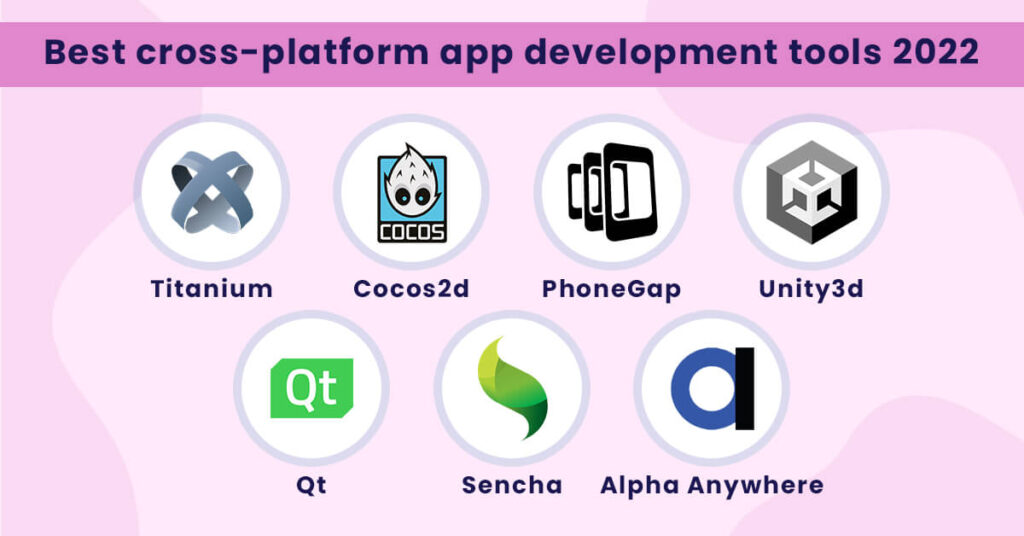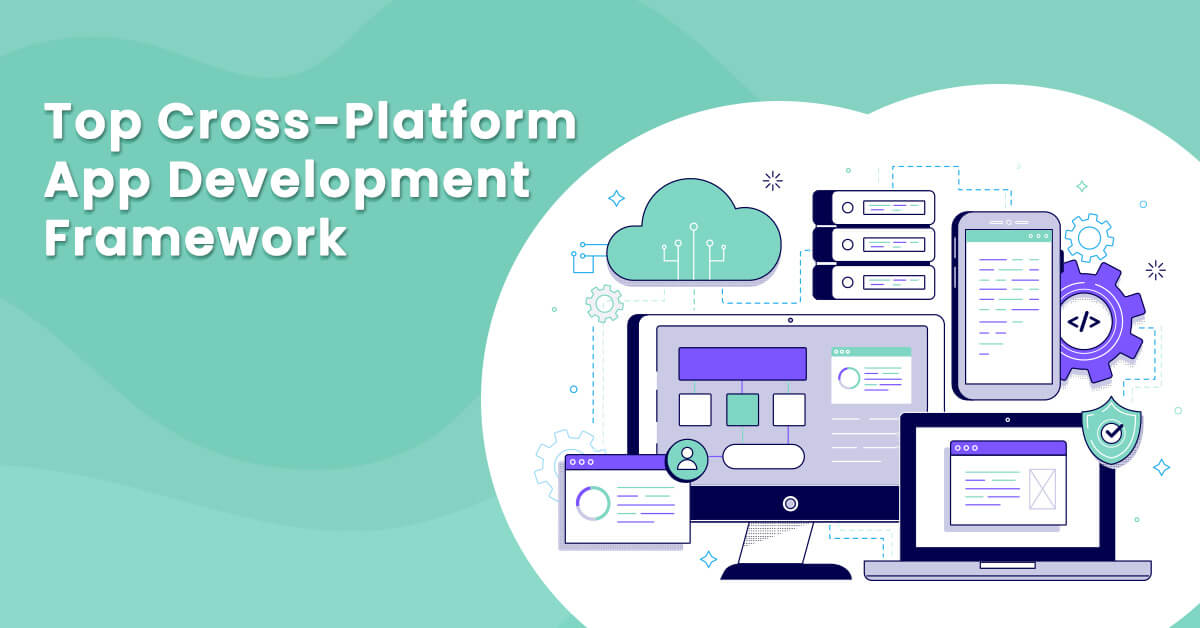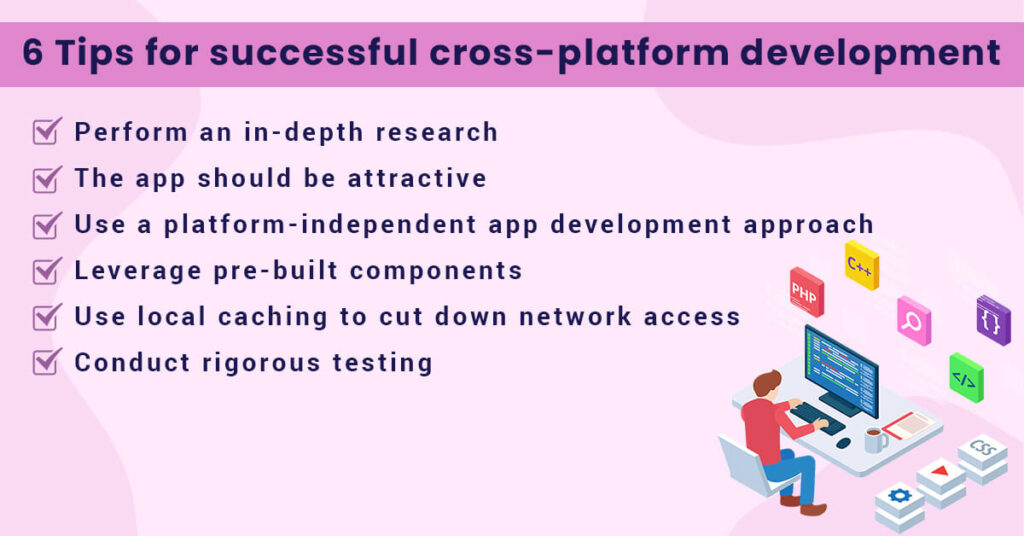
There are more than 4.4 million apps available on both App Store and Google Play today. These apps are installed on over 6 billion smartphones all over the world. The fast-growing market of mobile apps has lured many entrepreneurs towards it. If you are one of those entrepreneurs who want to launch a mobile app and have chosen to build a cross-platform app, then this write-up is for you.
We will discuss the advantages and disadvantages of cross platform development, have a brief look at the best app development tools and frameworks and give you a few tips for efficient cross platform app development.
Table of Contents
Current mobile app development service market
IoT is leading app market further. It allows the seizing of a huge amount of information that can be used for optimization and integration purposes.
The major affecting factors include smartphone penetration, IoT market growth, mobile usage, social media networks, and e-commerce industry.
According to Grandview research for the mobile app market growth, the market size amounted to $187.58 billion in 2021 and is projected to grow at a CAGR of 13.4% from 2022 to 2030.
In the wake of Covid-19, the exemplary growth of internet usage across developing nations becomes the reason for the accelerated use of mobile applications. The market in Asia-pacific industries is growing at the highest CAGR because of the highest smartphone adoption.
North America dominated the mobile app market with 31.83% of the revenue share in 2021 due to the presence of leading mobile giants in this region and expected to increase to $565.40 billion by 2030. The established markets will also experience revenue growth in the future.
The mobile app market trends include the adoption of various devices and the growing requirement of the ecommerce industry. The continuous growth in enterprise apps is also propelling both platforms to grow more and increasing the demand to hire developers for their mobile app development requirements.
Let’s look at some of the statistics:
- The majority of the time Americans spend on checking phones, wherein 88% of the time is spent browsing mobile apps.
- Android maintained its position as the leading mobile operating system worldwide in 2022 with a 70% share, while iOS accounted for around 28% of the mobile OS market.
- Roughly, one-third of mobile developers prefer leveraging cross-platform frameworks rather than native counterparts.
The above figures not only show the market trends but also share the prediction for a slew of entrants, who are making headway into mobile phones.
Sticking to a single platform is not a prudent strategy for mobile app development companies today and if the businesses want to reach a bigger audience base, they need to spread their services to a wider array of platforms.
Why Cross-platform app development?
With many different platforms emerging in parallel, going for 100 percent native Android or iOS is a daunting task. Also, it is time-consuming and costly to code the app and UI for the individual platform while they look and functions nearly the same. The solution to this problem is moving ahead with a Cross-platform development approach that enables building an app for multiple platforms at the time and cost of building an app for one platform leveraging a third-party software development kit. It’s a good deal.
Let’s look at the below facts:
- The code and database reusability saves development efforts and time, which automatically reflects reduced development time.
- Having different apps with multiple backends increases the upgrade and maintenance overhead. The cross-platform app development enables rendering upgrades to all the platforms in a single go.
- A good UX is a key to success. The cross-platform app development facilitates a similar UI across all the platforms, which results in better acceptability.
Popular cross-platform tools for app development
As a business owner, you need to have some knowledge about the various tools used in cross-platform mobile app development.
To aid you in your quest, we have identified the most popular cross platform tools for 2024 based on performance, feature support, cost, and framework risk.
- Titanium
- Cocos2d
- PhoneGap
- Unity3d
- Qt
- Sencha
- Alpha Anywhere
- Corona
Basic knowledge of the various tools used will help you discuss the same with your multi-platform app development team, and this, in turn, will help you select an appropriate team.
Best cross-platform app development frameworks
One of the most important questions that you need to ask your cross-platform app developers is the cross-platform app development framework that they would be using to develop your app. The quality of the end product won’t only depend on the kind of cross-platform app development framework selected but also on the experience and skill set of the cross-platform app developers with the selected framework. Ensure that the developers working on your cross-platform app have experience in building a cross-platform app on the framework on which they are going to build your cross-platform app.
There are various cross-platform frameworks available that streamline cross-platform mobile app development for multiple platforms globally. The frameworks are leveraged in different numbers because of the bouquet of tools they offer and the differences in popularity. Let’s understand top cross-platform frameworks in detail that are currently popular in app development market.
Most popular cross-platform app development frameworks:
Flutter
Flutter is one of the most popular cross-platform app development technologies available today. Flutter has a solid backing of Google and this fact makes it one of the top reasons why developers choose to go with Flutter for cross-platform app development.
The product was officially released in the market by Google in 2017 to build cross-platform applications on Android, iOS, Linux, Windows, macOS, Google Fuchsia, and web apps. The natively compiled, multi-platform framework allows developers to develop high-quality apps without writing codebase repetitively for every individual platform.
Nearly 40,668 apps are powered by Flutter with some leading players leveraging the technology. If you want to get results that giants have enjoyed, hire Flutter app developers for winning outcomes. Flutter has got credibility due to the fact that many leading businesses have chosen Flutter for cross-platform app development like- BMW, Toyoto, Google Pay, Dream11, Alibaba Group, and others.
React Native
React Native is another top cross-platform app development technology used backed by another tech behemoth, Meta.
The framework was built by the Facebook team way back in 2015 as a part of internal development. Later, the firm opened the gates of react native API for the world of cross-platform development. the framework enables developers to get build the app for iOS, Android, and web apps using the same codebase.
It’s a boon for the IT development space as it makes complex and repetitive tasks simple with components reuse and recycling that eliminates the need to build them from scratch. Also, codebase sharing makes development faster as developers only need to wrap the codebase into native containers and publish it on the respective app store.
React native is used by more than 34,000 apps to compose mobile UI from declarative components. The top brands like- Tesla, Meta, Walmart, Skype, Bloomberg, Instagram, Flipkart, Uber, and Netflix leveraging this framework. React native app developers can help you avail of the react native framework benefits by leveraging their expertise and experience in the same niche.
Xamarin
Microsoft is behind Xamarin, which happens to be a decent multi platform app development technology. Although not as popular as Flutter or React Native, Xamarin is still preferred by many cross-platform app developers in the industry.
The cross-platform development enables app development for iOS, Android, and Windows platforms using HTML, C#, and .NET at speed because of the ability to use 90% of code. It renders a native-like feel to the application by providing a link to native libraries, unlimited customization facility, and access to native-level functionality.
Specific APIs and plugins alleviate the hardware compatibility problems to a large fraction. With the WORA approach, the reduced development time and efforts make app development cost-effective. The straight inclusion of C++ libraries, Java, or Objective C enables the application developers to reuse third-party codebases encrypted in the aforementioned languages.
Node.JS
Node.JS is the most used web framework globally in 2022 with a 47.12% share in building cross-platform applications. The JS-based runtime framework supports scalable networking apps and server-side app development that is highly responsive and efficient. The single-thread nature of the framework ensures the app functions smoothly and doesn’t buffer as the app’s output data is received in chunks.
The asynchronous nature of Node.JS APIs signals a non-blocking nature that in turn won’t require servers to wait for data from APIs. As Node.JS is built on top of Chrome’s V8 engine which makes the code execution process faster. As the cross-platform framework increasingly becomes a top choice for organizations, expert Node.JS developers can help in building a responsive application that runs glitch-free.
Ionic
Angular.JS-based cross-platform framework is popularly known for enabling the usage of leading programming languages such as Cordova, HTML, CSS, and JavaScript. It’s known for building intuitive UI and user-friendly features that are later wrapped in native shells, which makes it an ideal candidate for PWA development.
Easy customization in code structure makes it a favorite of developers. Cordova plugin leverage facilitates accessing the device’s native features such as GPS, map, in-built camera, and other sensors.
Kotlin
You would be surprised to see Kotlin under the cross-platform development category, but the Kotlin framework extended its capabilities for multiplatform development. Going beyond Android development, the platform enables developers to share code, data, and business logic across different platforms such as iOS, web, Linux, JVM, and macOS.
Kotlin has low learning curve (Kotlin familiarity makes it easy to learn Kotlin multiplatform), render high performance (Kotlin code compile in the same format of targeted platform), and give freedom to UI developers to customize the UI and UX design limitlessly. Netflix, Careem, and Pinterest consider this platform for multiplatform development.
If you also want to deploy the app beyond mobile, web, and desktop using Kotlin framework, professional Kotlin developers can help at scale.
All the above cross-platform app development frameworks mentioned above have their own pros and cons. You should select the best multi-platform app development framework according to the specific needs of your cross-platform app. Your cross-platform app developers can help you make the correct choice.
PhoneGap
When PhoneGap is selected to build hybrid apps, developers can write a single codebase using HTML5, CSS, and JS languages, which is later converted by the framework into an app. Native plugins are also provided for every platform that enables accessing native device features such as camera, microphone, compass, and more.
Cordova
The framework leverages standard technologies like- HTML5, CSS, and JS to develop hybrid apps that run in an integrated mobile web browser, that is essentially a WebView. With no need to learn platform-specific languages and access to native features through plugins, the app development time is reduced which results in faster time-to-market.
How much does Cross-platform App Development Cost?
Specifying the exact cost for cross-platform app development is implausible as there are large variations across the board when it comes to cost estimation. The cost to develop a cross platform mobile app is quite less expensive as compared to native counterparts.
The simple app development with a basic set of features and simple UI shells out nearly $10,000 with development time elongating to 3 months.
The complex apps with a set of basic and advanced features, appealing UI, and the latest tech stack require a qualified team of professionals that makes the businesses pay around $50,000. Also, it’s variable depending on the hourly rate of the cross platform app developer’s location.
For instance, when a cross platform or hybrid app development company based in the USA leverages Ionic as a cross platform app development framework to build a simple app, it costs around $15,000.
Hybrid app development can be a good choice for businesses and one can consider a mobile app development outsourcing option to reduce the cross-platform app development cost by a large margin.
Tips for developing cross-platform apps
You need to take care of a few aspects when you go for cross-platform app development. How well you deal with these aspects will decide the success or failure of your cross-platform app. We have given below a few tips to effectively handle cross-platform development.
Perform an in-depth research
All good cross-platform apps have one thing in common, robust market research. In-depth market research will provide you with valuable insights into the demands of app users and also help you get a credible cost estimation of the project. The market research will also unveil the strategies your competitors are using to solve the problems of the users. While conducting market research, be sure to be customer-centric and develop a cross-platform app that focuses directly on the customer pain points.
Do not forget to take into consideration the latest cross-platform app trends when you conduct market research. Whether it is about building MVP or a full-fledged app, good market research always helps to build a feature-rich cross-platform app.
The app should be attractive
The first thing that will attract users towards it is the look and feel of the app. A visually appealing app would contribute positively to user engagement. Follow the UI/UX design principles to build a design that is both unique and consistent.
iOS, Windows, and Android all use different types of schemes and fonts. So you will have to specifically customize each of these fonts to ensure that the app functions smoothly. Choose imagery that is consistent with your brand and always have a platform-independent vision of how you want your app to look.
Use a platform-independent app development approach
Many developers tend to think that with cross-platform development, there is no need to consider platform-specific interface standards. This is an incorrect approach as there are some Android-specific features and some iOS-specific features. mobile app development companies will know what iOS users expect from an app and what Android users expect from an app. Poor cross-platform app developers won’t be able to take advantage of these non-generic features.
You must find a balance between design consistency and platform guidelines. A good cross-platform app should be easy to use and should align perfectly well with each type of platform. Using HTML & CSS, the developers can easily customize your app. The developers need to do a little work to add minimal DOMs and a few CSS lines for every mobile platform.
Leverage pre-built components
Most of the popular cross-platform app development technologies have a wide range of reliable and pre-tested code components available. Using these pre-built components, cross-platform app developers can build an app quickly and easily. So make sure that you are not paying your cross platform app developers to reinvent the wheel. By plugging one of the ready-made modules into your app development project, you can reduce the production time and improve both quality and performance.
In case your app developers have experience in building a solution similar to yours, then they would already have a lot of the pre-built components necessary to build a cross-platform app. Before you give your cross-platform app development project to any development team, make sure you ask the team how much of the project they intend to build from scratch and how much will they use pre-built components.
Use local caching to cut down network access
With certain hybrid frameworks, the developers can boost the app’s performance by storing information in local storage or by rendering information through cache. The developers can substantially reduce server calls and network requests when they utilize local storage for caching purposes. The app runs smoothly as the pages load instantly from the cache.
Ask your developers to fetch and pre-load the data whenever possible. One can minimize access to the DOM by reducing the number of DOM elements and updating them ‘offline’ before reinserting them into the DOM. The developers can reduce the burden on the app as both static as well as dynamic data can be saved locally.
Conduct rigorous testing
Rigorous testing is important to ensure the success of your cross-platform app. Before you release it to the market, ensure that every aspect of the app, right from design, loading speed, and performance, is up to the mark. The developers can use tools like Istanbul, Jasmine, Karma, and Mocha to test the codebase.
Tools like Browser-Perf can help your developers test the performance right on the browser. New Relic lets you monitor issues like response time. Discuss with your cross-platform developers the approach of testing the app, the tools they are going to use, and the resources that they will deploy to test the app. An efficient cross-platform app development company would have a robust app testing procedure that will help them deliver a high-quality app.
Cross-over to cross-platform
Cross-platform app development has reduced the costs of mobile app development. With tech heavyweights like Google, Meta, and Microsoft throwing their weight behind cross-platform apps, the future looks bright for cross-platform development. Great things happen when efficient teams collaborate. This is true for cross-platform app development as well. Collaborate with a good cross-platform app development company to build a great cross-platform app.
The questions that are asked by clients
What is a cross-platform app development framework?
A cross-platform app development framework provides all the tools required to build an application that runs on multiple platforms. Based on the write once and run everywhere approach, the framework enables native-like app development.
What are the Best Cross Platform Frameworks for Developing Mobile Apps?
Flutter, React Native, Xamarin, PhoneGap, and Node.js are among the top frameworks that are used by cross-platform app developers and are widely considered depending on the project type and requirements.
How much does it cost to make a cross-platform app?
Cross-platform development shell out comparatively less amount as opposed to native development due to reduced resources, efforts, and time consumption. The basic cross-platform app development cost range starts from $10,000-$25,000 based on the app’s complexity and type. The framework used to develop the cross-platform app and the experience level of the app developer also make considerable changes in the budget of cross-platform app development.
 Avantika Shergil
| Dec 8, 2022
Avantika Shergil
| Dec 8, 2022
Avantika Shergil is a technology enthusiast and thought leader with deep expertise in software development and web technologies. With over 8 years of experience analyzing and evaluating cutting-edge digital solutions, Avantika has a knack for demystifying complex tech trends. Her insights into modern programming frameworks, system architecture, and web innovation have empowered businesses to make informed decisions in the ever-evolving tech landscape. Avantika is passionate about bridging the gap between technology and business strategy, helping businesses build customized software and website, and understand about different tools to leverage effectively for their ventures. Explore her work for a unique perspective on the future of digital innovation.








